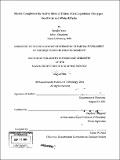Model complexes for active sites of diiron metalloproteins, dioxygen reactivity and water effects
Author(s)
Yoon, Sungho, 1971-
DownloadFull printable version (9.552Mb)
Other Contributors
Massachusetts Institute of Technology. Dept. of Chemistry.
Advisor
Stephen J. Lippard.
Terms of use
Metadata
Show full item recordAbstract
(cont.) tetrairon(II) cubane complex was identified and structurally characterized. Chapter 4: Synthesis and Characterization of [Fe₂...CR)]³⁺ and [Fe₂...CR)]³⁺ Complexes with Carboxylate-Rich Metal Coordination Environment as Models for Diiron Centers in Oxygen-Dependent Non-Heme Enzymes. Utilizing hydrogen bonding interactions and sterically bulky carboxylates, synthetic routes were developed to prepare the mononuclear iron(II) complexes with the vacant coordination sites for O₂ binding. Reactions of such complexes with O₂ resulted in rare asymmetric complexes having an [Fe₂...CR)]³⁺ or [Fe₂...CR)]³⁺ unit. These diiron(III) complexes with carboxylate-rich metal coordination environments reproduce the diiron(III) cores housed in four-helix bundles found in nature. Compound 3, which replicates the [Fe₂...CR)] core of sMMOH[ox], shares several physical properties with the enzyme, electronic transitions, Mossbauer spectra, and magnetic exchange interactions. On the other hand, the structure of 4, ([mu]-oxo)([mu]-carboxylato)diiron(III) complex, mimics the diiron(III) sites of RNR-R2. The electronic and Mbssbauer spectral transitions of 4 are typical of diiron(III) complexes with an Fe-O-Fe moiety. Magnetic exchange coupling interaction between the two iron atoms is within the expected range for oxo-bridged diiron(III) sites. These results demonstrate how the diiron(III) structures in different metalloproteins, namely, the [mu]-oxo cores of RNR-R2 and the [mu]-dihydroxo unit in MMOH, can be replicated by subtle changes in ligand composition ... Chapter 1: Modeling Studies for Diiron Sites with Carboxylate Rich Coordination Environments in Dioxygen-Dependent Non-Heme Enzymes: Compounds Synthesized, Understanding Achieved, and Directions to Take. Our efforts to better understand of dioxygen-dependent diiron proteins with carboxylate-rich coordination environments through synthesis of small model complexes are summarized. We describe both not only the significant results that have contributed toward this goal, but also the rationale behind how one generation of model systems gave way to the next. Chapter 2: Mechanistic Studies of the Oxidative N-Dealkylation of a Benzyl Group Substrates Tethered to Carboxylate-Bridged Diiron(II) Complexes, [Fe₂...Bn₂en)₂]. Hammett and intramolecular kinetic isotope effect (KIE[intra]) analyses for oxidative N-dealkylation of [Fe₂...Bn₂en)₂] rule out previously proposed concerted and hydrogen atom transfer mechanisms. We conclude that the reaction operates through single-electron transfer from the non-bonding electron pair of the amine substrate to the dioxygen-generated intermediate, followed by proton transfer and rearrangement. Chapter 3. Synthesis, Characterization, and Dioxygen Reactivity of Tetracarboxylate-Bridged Diiron(II) Complexes with Coordinated Substrates. The synthesis and characterization of [Fe₂...L₂] complexes, where L is benzylamine (BA) or 4-methoxybenzylamine (BAP[p-OMe]), and their oxygenation are described. Various methods, including resonance Raman (rR) and electron paramagnetic resonance (EPR) spectroscopy, have been applied to understand the mechanism and the intermediates involved. In addition, upon dissolution of the tetracarboxylate-bridged diiron(II) complex in methanol, an asymmetric
Description
Thesis (Ph. D.)--Massachusetts Institute of Technology, Dept. of Chemistry, 2004. Includes bibliographical references.
Date issued
2004Department
Massachusetts Institute of Technology. Department of ChemistryPublisher
Massachusetts Institute of Technology
Keywords
Chemistry.